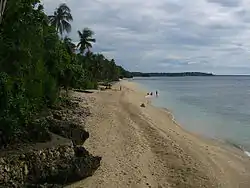Siaton
Siaton, officially the Municipality of Siaton, is a 1st class municipality and the southernmost settlement in the province of Negros Oriental, Philippines. According to the 2015 census, it has a population of 77,696 people. [3]
Siaton | |
|---|---|
| Municipality of Siaton | |
 Antulang Beach at Siaton | |
| Nickname(s): Southland by the Sea | |
 Map of Negros Oriental with Siaton highlighted | |
OpenStreetMap 
| |
.svg.png.webp) Siaton Location within the Philippines | |
| Coordinates: 9°04′N 123°02′E | |
| Country | |
| Region | Central Visayas (Region VII) |
| Province | Negros Oriental |
| District | 3rd district |
| Barangays | 26 (see Barangays) |
| Government | |
| • Type | Sangguniang Bayan |
| • Mayor | Cezanne Fritz H. Diaz |
| • Vice Mayor | Vincent Emil T. Arbolado |
| • Representative | Arnolfo A. Teves Jr. |
| • Electorate | 50,737 voters (2019) |
| Area | |
| • Total | 335.90 km2 (129.69 sq mi) |
| Elevation | 103 m (338 ft) |
| Population | |
| • Total | 77,696 |
| • Density | 230/km2 (600/sq mi) |
| • Households | 17,820 |
| Economy | |
| • Income class | 1st municipal income class |
| • Poverty incidence | 52.92% (2015)[4] |
| • Revenue | ₱176,902,633.02 (2016) |
| Time zone | UTC+8 (PST) |
| ZIP code | 6219 |
| PSGC | |
| IDD : area code | +63 (0)35 |
| Climate type | tropical climate |
| Native languages | Cebuano Magahat language Tagalog |
The town is home to the Minagahat language, the indigenous language of Southern Negros as listed by the Komisyon ng Wikang Filipino. The language is vital to the culture and arts of the people.
Lake Balanan is located in Siaton.
Barangays
Siaton is politically subdivided into 26 barangays.
- Albiga
- Apoloy
- Bonawon
- Bonbonon
- Cabangahan
- Canaway
- Casala-an
- Caticugan
- Datag
- Giliga-on
- Inalad
- Malabuhan
- Maloh
- Mantiquil
- Mantuyop
- Napacao
- Poblacion I
- Poblacion II
- Poblacion III
- Poblacion IV
- Salag
- San Jose
- Sandulot
- Si-it
- Sumaliring
- Tayak
Climate
| Climate data for Siaton, Negros Oriental | |||||||||||||
|---|---|---|---|---|---|---|---|---|---|---|---|---|---|
| Month | Jan | Feb | Mar | Apr | May | Jun | Jul | Aug | Sep | Oct | Nov | Dec | Year |
| Average high °C (°F) | 31 (88) |
31 (88) |
32 (90) |
33 (91) |
31 (88) |
30 (86) |
29 (84) |
29 (84) |
29 (84) |
29 (84) |
30 (86) |
30 (86) |
30 (87) |
| Average low °C (°F) | 22 (72) |
22 (72) |
22 (72) |
24 (75) |
25 (77) |
25 (77) |
25 (77) |
25 (77) |
25 (77) |
25 (77) |
24 (75) |
23 (73) |
24 (75) |
| Average precipitation mm (inches) | 46 (1.8) |
45 (1.8) |
56 (2.2) |
83 (3.3) |
163 (6.4) |
203 (8.0) |
236 (9.3) |
204 (8.0) |
210 (8.3) |
211 (8.3) |
143 (5.6) |
77 (3.0) |
1,677 (66) |
| Average rainy days | 12.1 | 9.8 | 14.3 | 17.5 | 26.0 | 27.8 | 28.4 | 26.9 | 26.7 | 27.9 | 23.3 | 17.2 | 257.9 |
| Source: Meteoblue [5] | |||||||||||||
Demographics
| Year | Pop. | ±% p.a. |
|---|---|---|
| 1903 | 10,074 | — |
| 1918 | 13,183 | +1.81% |
| 1939 | 16,968 | +1.21% |
| 1948 | 17,926 | +0.61% |
| 1960 | 22,467 | +1.90% |
| 1970 | 26,963 | +1.84% |
| 1975 | 34,316 | +4.96% |
| 1980 | 38,612 | +2.39% |
| 1990 | 48,982 | +2.41% |
| 1995 | 57,313 | +2.99% |
| 2000 | 64,258 | +2.48% |
| 2007 | 67,943 | +0.77% |
| 2010 | 73,285 | +2.79% |
| 2015 | 77,696 | +1.12% |
| Source: Philippine Statistics Authority [3] [6] [7][8] | ||
Notable residents
- Felix Makasiar, 14th Chief Justice of the Philippine Supreme Court[9]
References
- Municipality of Siaton | (DILG)
- "Province:". PSGC Interactive. Quezon City, Philippines: Philippine Statistics Authority. Retrieved 12 November 2016.
- Census of Population (2015). "Region VII (Central Visayas)". Total Population by Province, City, Municipality and Barangay. PSA. Retrieved 20 June 2016.
- "PSA releases the 2015 Municipal and City Level Poverty Estimates". Quezon City, Philippines. Retrieved 12 October 2019.
- "Siaton: Average Temperatures and Rainfall". Meteoblue. Retrieved 6 May 2020.
- Census of Population and Housing (2010). "Region VII (Central Visayas)". Total Population by Province, City, Municipality and Barangay. NSO. Retrieved 29 June 2016.
- Censuses of Population (1903–2007). "Region VII (Central Visayas)". Table 1. Population Enumerated in Various Censuses by Province/Highly Urbanized City: 1903 to 2007. NSO.
- "Province of". Municipality Population Data. Local Water Utilities Administration Research Division. Retrieved 17 December 2016.
- "Chief Justice Felix V. Makasiar". Supreme Court of the Philippines. Retrieved 2010-06-05.
External links
| Wikimedia Commons has media related to Siaton. |
- Sibulan Profile at PhilAtlas.com
- Philippine Standard Geographic Code
- Philippine Census Information
- Local Governance Performance Management System
This article is issued from Wikipedia. The text is licensed under Creative Commons - Attribution - Sharealike. Additional terms may apply for the media files.